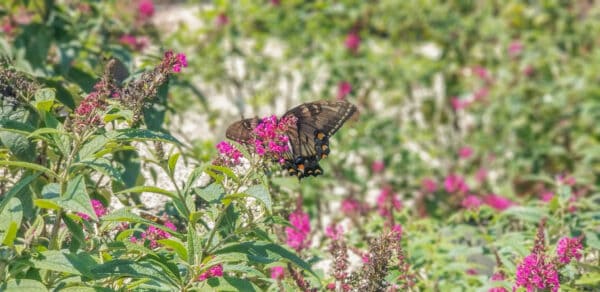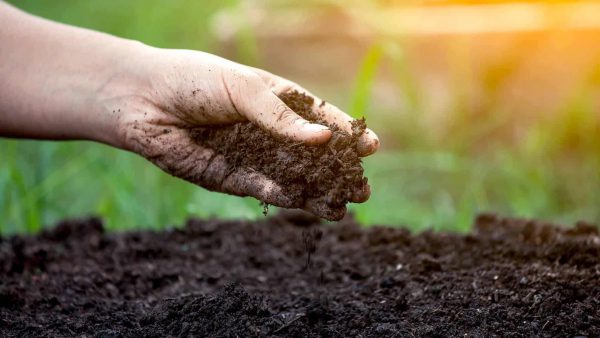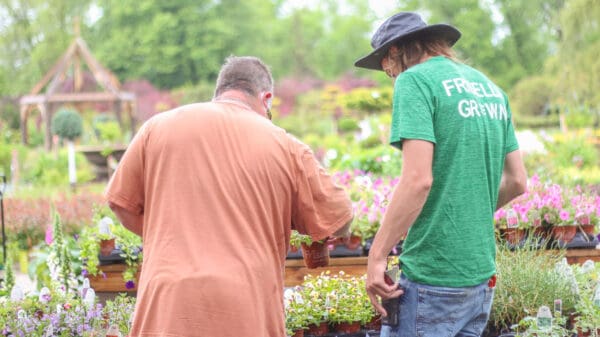Starting a garden is very fun and exciting. We got some great tips from Laura Hill, Frisella Garden Center Manager, for starting a garden. Gardening is going to mean something different to everybody, we are going to go over some different variations of gardens. Some people may want different kinds of gardens depending on their wants and needs such as a butterfly garden, a veggie garden or maybe a meditation garden.

Let’s jump into talking about butterfly gardens or pollination gardens. These gardens may attract butterflies, hummingbirds, bees and other life that go to the plants specifically for the pollen. With any kind of pollinator garden, about 98% of those plants are going to want as much sun as possible. So when you are looking for a place in your yard to
place a butterfly garden, pick a place that gets good sun exposure and does not have many trees that could give off shade. Laura says, “We get people that come into the garden center who want to start a pollinator garden and they live in an old home or on older property that have these great big, beautiful shade trees in the yard. Well, if you want to start a pollinator garden, you’ve got to have a lot of sun so that may not be the best garden for your yard.”
So we said that butterfly or pollination gardens need a lot of sun but how much sun is that exactly? As a rule of thumb, “full sun” typically means 6-8 hours of sunlight per day. So sun loving plants are going to look for a minimum of 6 hours of sunlight each day. If the plants get any less than that minimum of 6 hours, then you may be sacrificing blooms. Any plant that is considered a full sun plant that doesn’t get enough sunlight is not going to bloom like it should.
You may be a beginner gardener starting out with a little 4’x4’ area or maybe a little hole that you dug in your existing landscape, so what kind of soil amendment should you do to your new garden space? We recommend that anytime you
have the opportunity, you should always amend your soil. Luckily many pollinator plants are hybridized so that they are able to tolerate a range of different soil types. Plants like bee balm, cone flowers and others that you typically include in a
pollinator garden can generally tolerate a pretty wide range of soils. With that being said, not just any plant is going to
necessarily thrive in your native clay soil or the red clay soil that contractors bring in to new developments but they will adjust.

Just for a rule of thumb, dig a hole twice as big as the plant or if you want to plant a bunch of plants close together to get that instant impact, dig out the whole area but do not get rid of the soil. You don’t want to fill a brand new hole with clay
soil because it is basically a bowl that will just hold water. Instead, you want to mix your existing soil with a good top soil mix, that way the plants can start to acclimate to the existing soil conditions. This will basically create a base layer where the roots can start in and then grow stronger down into the native soil.
Now let’s talk about watering. Most pollinator plants are going to be more drought tolerant. They do not need a ton of water and they don’t like wet feet, meaning when the plants sit in water and not draining properly, they may start developing fungal issues and rot in the base of the plant. This is generally a problem in the spring time when people are super excited to plant all of these new things but we are getting mass amounts of rain. There is a massive difference in the lawn or turf water requirements versus flower bed/pollinator garden water requirements. So be sure to know what kind of water schedule your garden should be on.
You may not have the picture perfect place in your yard to plant exactly what you want to but certainly doesn’t hurt to give them a try. Laura says that she always tells people that every plant is different and beginner gardeners should not be afraid to try something new. If you think you want to try something, you might as well because you can always pop out the plant and move it somewhere else if what you tried is not working. Just be sure to keep a close eye on your plants and evaluate how they are doing.
The last topic on butterfly gardens is care. Again, we always encourage people to amend their solid if they are able to do so. Your plants will thank you and you will be very glad that you did in the long run. If you are able to amend your soil it is good to use a bio tone starter fertilizer. Many pollinator plants are not heavy feeders but in their bloom cycles, they are going to require a lot more nutrients. This is because they need more energy to produce those big blooms that will attract the pollinators such as butterflies. Other than a good plant tone regimen, there is not much more care that goes into pollinator gardens.
Let’s move on to vegetable gardens. Many people love the garden to table concept and one of the many benefits of having your own veggie garden is that you know exactly where your veggies are coming from, how the plants are grown,
soil/chemicals used and who is picking and handling your veggies. If you get your produce from a grocery store, you don’t know how many people have touched or picked up the exact head of lettuce that you are bringing home and eating for dinner. The thought of knowing exactly where your plant comes from is very attractive to a lot of people when deciding to start a vegetable garden.
In the beginning stages of planting a veggie garden you should consider your strengths, your time allotment and other things like that. Laura suggests that if you have never had a veggie garden or if you are unsure of your gardening skills,
you can always start with just a tomato plant and a pot. Get a really pretty ceramic pot that you can plant up from season to season with different seeds to try out without having a massive investment or time investment in it.

Another great tip from Laura for beginner gardeners is to get a notebook and take notes from year to year about your plants, growth, what works well and what does not work well. You can never remember what you hated about last season when you are super excited about this upcoming season but if you take notes it’s going to change the garden game for you every single year.
The easiest plants to start a veggie garden with are going to be leafy greens like lettuce, spinach and cabbage. Radishes are also one of the most quick turning, instant gratification veggie crops that you can grow. Green beans are another very easy veggie to plant for beginners that produce great results. You can get handfuls and handfuls of green beans and you can always put them into cans or freeze for future use.
Let’s jump into beginner gardening tools. Having the proper high quality tools makes a massive difference in what you’re doing in your garden. Any kind of tools that make your time more enjoyable and productive in the garden is going to help you succeed and enjoy yourself more. Always be sure to talk to an associate when you come into the garden center because if you don’t know what you’re looking for or looking at it can get overwhelming or confusing. Laura recommends that beginner gardeners get a tool for weeding called a Cobra, it has two metal prongs (shaped like a snake tongue) and a wooden handle. It is a bit of a higher price but it’s very high quality and honestly, you do not want a cheap weeder. Weeding is something that always seems to get away from beginner gardeners. However, if you have the right tools that are comfortable to use, your time in the garden is going to be much more enjoyable and efficient. A few other beginner
gardening tools to get would be a pair of hand pruners, a shovel, and a hose.
If you come into our garden center at Frisella Nursery you will find an awesome seed supply and many great tools for
starting a garden. We bulked up early because within the past year we have seen so many people becoming more and
more interested in starting their own garden. There are so many beginner type options for starting a garden whether it is a butterfly garden, veggie garden or cut flower garden. In our garden center we can walk you through step by step of starting your perfect garden.
If you have any questions, please feel free to email us at help@frisellanursery.com. We are going to have a lot of garden giveaways this year so be sure to follow us on social media and stay up to date with everything going on here at Frisella Nursery!
